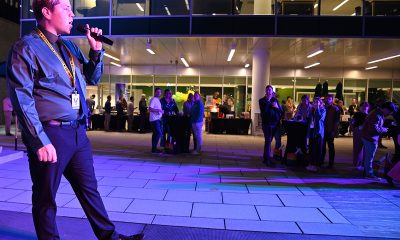a&e features
Virginia Opera conductor enjoys musical challenge
Adam Turner preps 2 performances of ‘La Boheme’
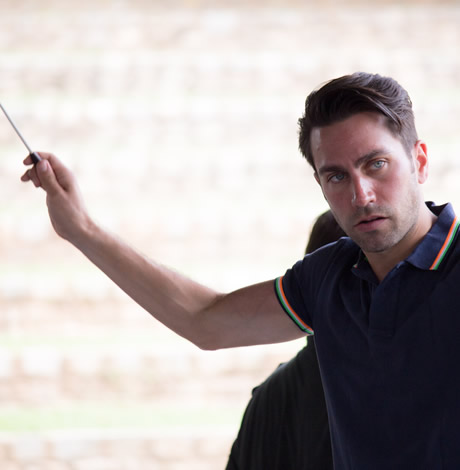

Adam Turner says traditional arts companies must be willing to try new things if they hope to appeal to millennials. (Photo by Keitaro Harada; courtesy Virginia Opera)
‘La Boheme’
Giacomo Puccini
Virginia Opera
Saturday, Nov. 14 at 8 p.m.
Sunday, Nov. 15 at 2 p.m.
George Mason University
Center for the Arts
4400 University Dr.
Fairfax, VA
Tickets: $98, $80 and $48
Adam Turner, principal conductor and artistic adviser of Virginia Opera, moved to Norfolk, Va., four-and-a-half years ago after attending college at D.C.’s Catholic University.
Next weekend, he’ll return to the Washington area to give two performances of Puccini’s “La Boheme” at George Mason University in a production the company is also doing this weekend (Nov. 6, 8 and 10) in Norfolk and in Richmond on Nov. 20 and 22.
Turner will be in the pit directing a 50-piece orchestra (the Virginia Symphony) with seven leads, a chorus of 24 and a 12-voice children’s choir.
“It’s like a huge old circus up there,” the 33-year-old Louisville, Ky., native says. “It’s a lot of people to manage and keep on the same track.”
We spoke with him during a break in rehearsals last week.
WASHINGTON BLADE: Was it a big adjustment moving to Norfolk from Washington?
ADAM TURNER: The short answer is yes. It was a pretty big adjustment because it’s just a different pace of life, I think, down here. But I enjoy it, being this close to the water. The Hampton Roads community when you put it all together is over a million people spread out over Virginia Beach, Hampton and Newport News yet it still feels kind of like a small town where everybody knows everybody. But there’s a good restaurant scene and the arts are extremely valued here so that’s what drew me.
BLADE: Tell us about “La Boheme.”
TURNER: It’s very romantic and super relevant and a familiar story to anyone who has ever been in love or who has an artistic side to them. It’s just one of those pieces that really resonates with just about anyone. … There’s an episode of “The Simpsons” where Homer wakes up from a coma and suddenly he’s an opera singer and he sings “La Boheme.” I remember thinking, “Wow, opera is everywhere … even ‘The Simpsons.’” It’s one of the classics.
BLADE: Was there opera in Louisville when you were growing up?
TURNER: My grandmother took me to “The Nutcracker” every year and later I saw Broadway musicals like “Phantom of the Opera” and “Starlight Express.” … Then when I was a little older, I saw my first opera in Louisville, which was “The Magic Flute.” I think just basically the vocal acrobatics of it and the stamina and the talent you need to sing those roles was just overwhelming. It really left an imprint on me.
BLADE: Is there overlap between the worlds of opera conducting and symphonic conducting? Do some conductors do both?
TURNER: I think the old-school conductors trained in Europe did both and always started in the opera house and then went to symphony conducting or ballet conducting or whatever. It was something that was just included and considered part of your job, but opera conducting is probably the most challenging work there is in classical music performance and I think that’s why I probably am drawn to it because it is such a challenge. There’s a lot more to manage and not only are you leading the orchestra and influencing the music and all of that, but you’re also keeping all these forces together, you know, uniting them with the same vision and the same precision. … Anytime I’ve done anything orchestral or with soloists, I love it, but I always kind of am wondering, “OK, where are the singers?”
BLADE: Why?
TURNER: I think singers give so much more drama to the process and they need attention and a lot of care and tenderness, care and attention. I just work really well with them. … It’s a real challenge but a fun challenge.
BLADE: Is opera your first love or conducting or did you sort of discover them simultaneously?
TURNER: I think I discovered them simultaneously. The first time I ever saw conducting was when I was 5 or 6 and I was immediately taken by the conductor and all he was doing and thinking, “Oh, I want to do that someday.” … I grew up listening to Elton John and Ben Folds and Billy Joel, you know, piano men, and then somewhere along the way I found out about Pavarotti and Domingo and all these famous opera singers and I was really attracted to that sound and just the romanticism of the music and I kind of float both sides. I really like pop music and old-school rock but then I’m just as happy working in opera which I think is just one of the more challenging things because it pulls all these great art forms together.
BLADE: There’s lots of handwringing in classical music. How are things overall at Virginia Opera?
TURNER: When I first came here there had been some major upheavals with the artistic director. He had been fired so there was a lot of instability and uncertainty about what the future direction was going to be. So I was hired to provide artistic stability and also some new fresh energy to the company and along with that, my goal was really for us to find new audiences, people my age. I would love to see more 20- and 30-somethings in the opera house and how do we do that? So for me the main goal was just getting people into the theater to experience it for themselves and let them know it’s not this scary, sacred institution. … Once they do that, they’re just overcome with the emotion and raw passion of live performance and live playing. … We try to find repertoire that will appeal to our seasoned opera goers … and also find a way to get new folks in. … Last year we did “Sweeney Todd” and it was thrilling to see so many young and new faces. … And then they come back and now they’re giving Puccini a run or maybe even Verdi or Mozart.
BLADE: There’s so much worry and prognosticating on this topic. Do you think when millennials get a little older, they will do a better job of picking up these batons or will our traditional arts companies continue facing challenges?
TURNER: I think they will face challenges if they don’t adapt and try new things and that’s the thing I keep harping on. We have to keep trying different approaches to find out what works best. People are all craving this kind of live experience. It’s not something you can get on Netflix sitting at home by yourself. Live acoustic performance is unlike any other form of entertainment and companies all over the world are trying new approaches. … We started an initiative where for the past five years, we’ve been doing one new production each season we’ve never done before in our 40-year history. … You have to do new things that will entice people to come to the theater and try a new piece they’ve never heard before.
BLADE: You’re running a marathon next Saturday the same day you’ll conduct in Fairfax. Why?
TURNER: I’m just crazy, that’s why. … I run all the time, sometimes up to 50 miles a week. It gives me so much more energy and really kind of sets the tone for my day and gives me a lot of focus and drive. … I just wanted to find a marathon that fit my schedule and this was the one that fit and that I thought I could handle.
BLADE: How long have you been out?
TURNER: Since I was 20. Basically in college in D.C., I blossomed, so to speak.
BLADE: Has opera been as gay as we typically think of it in your experience?
TURNER: People who like prissy things are attracted to opera and I think a lot of gay men appreciate beautiful singing and beautiful sets and costumes and the grandiosity of all that. I can certainly see why it would attract the gay culture. … All over the country there are gay men running opera companies … because they’re so passionate about the art form. I have no explanation for it or anecdote, but it’s refreshing to know we have all found our niche.
BLADE: Is there much gay life in Norfolk?
TURNER: Oh yeah, I have a great circle of friends here but it’s different than the gay community in D.C. or even in Richmond. It’s more laid back. I just found out last week that Norfolk has the highest gay marriage rate in the state. … I’m not getting married anytime soon, but I certainly enjoy dating and going out with my friends.
BLADE: You’re working on a production with the Washington National Opera next year. Does that have any connection to your work with Virginia Opera is that a separate thing altogether?
TURNER: That’s completely separate and I’ll be on staff for one of their productions as part of a fellowship I was awarded earlier this year. We strive to do different repertoire, like last year they did “La Boheme” and this year we’re doing it. Even though they’re totally separate productions and a completely different market … we strive to do our own thing.
BLADE: Who’s your favorite classic opera diva?
TURNER: I’m a huge fan of Marilyn Horne, a great mezzo-soprano. I tend to like the lower-voiced women.
BLADE: You were awarded a $10,000 stipend with the Julius Rudel/Kurt Weill Conducting Fellowship this year. What did you do with the money?
TURNER: It’s in savings, I haven’t done anything with it yet. I’ll probably use it for career-development stuff. Travel and networking stuff.
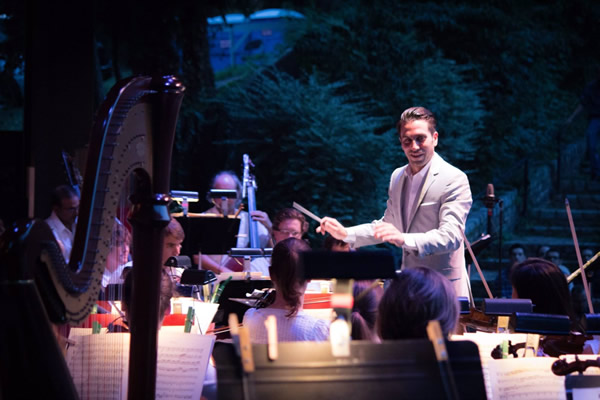
Adam Turner in action. Turner discovered opera growing up in Kentucky. (Photo courtesy Virginia Opera)
a&e features
Visit Cambridge, a ‘beautiful secret’ on Maryland’s Eastern Shore
New organization promotes town’s welcoming vibe, LGBTQ inclusion
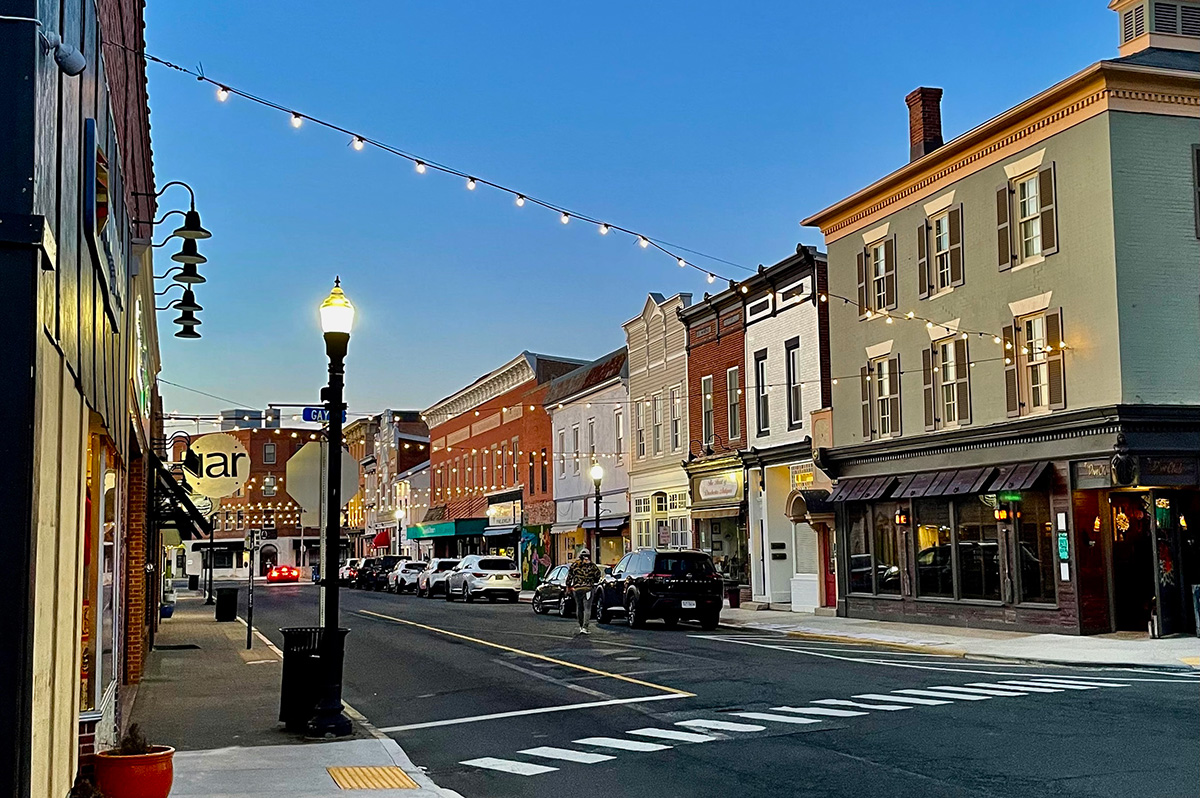
CAMBRIDGE, Md. — Driving through this scenic, historic town on Maryland’s Eastern Shore, you’ll be charmed by streets lined with unique shops, restaurants, and beautifully restored Victorian homes. You’ll also be struck by the number of LGBTQ Pride flags flying throughout the town.
The flags are a reassuring signal that everyone is welcome here, despite the town’s location in ruby red Dorchester County, which voted for Donald Trump over Kamala Harris by a lopsided margin. But don’t let that deter you from visiting. A new organization, Proudly Cambridge, is holding its debut Pride event this weekend, touting the town’s welcoming, inclusive culture.
“We stumbled on a beautiful secret and we wanted to help get the word out,” said James Lumalcuri of the effort to create Proudly Cambridge.
The organization celebrates diversity, enhances public spaces, and seeks to uplift all that Cambridge has to share, according to its mission statement, under the tagline “You Belong Here.”
The group has so far held informal movie nights and a picnic and garden party; the launch party is June 28 at the Cambridge Yacht Club, which will feature a Pride celebration and tea dance. The event’s 75 tickets sold out quickly and proceeds benefit DoCo Pride.
“Tickets went faster than we imagined and we’re bummed we can’t welcome everyone who wanted to come,” Lumalcuri said, adding that organizers plan to make “Cheers on the Choptank” an annual event with added capacity next year.
One of the group’s first projects was to distribute free Pride flags to anyone who requested one and the result is a visually striking display of a large number of flags flying all over town. Up next: Proudly Cambridge plans to roll out a program offering affirming businesses rainbow crab stickers to show their inclusiveness and LGBTQ support. The group also wants to engage with potential visitors and homebuyers.
“We want to spread the word outside of Cambridge — in D.C. and Baltimore — who don’t know about Cambridge,” Lumalcuri said. “We want them to come and know we are a safe haven. You can exist here and feel comfortable and supported by neighbors in a way that we didn’t anticipate when we moved here.”
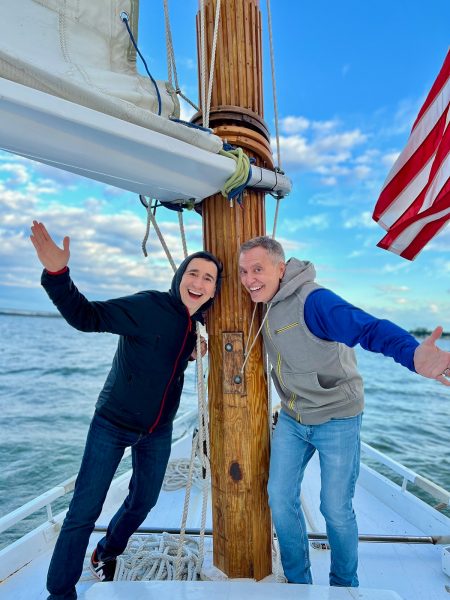
Lumalcuri, 53, a federal government employee, and his husband, Lou Cardenas, 62, a Realtor, purchased a Victorian house in Cambridge in 2021 and embarked on an extensive renovation. The couple also owns a home in Adams Morgan in D.C.
“We saw the opportunity here and wanted to share it with others,” Cardenas said. “There’s lots of housing inventory in the $300-400,000 range … we’re not here to gentrify people out of town because a lot of these homes are just empty and need to be fixed up and we’re happy to be a part of that.”
Lumalcuri was talking with friends one Sunday last year at the gazebo (affectionately known as the “gayzebo” by locals) at the Yacht Club and the idea for Proudly Cambridge was born. The founding board members are Lumalcuri, Corey van Vlymen, Brian Orjuela, Lauren Mross, and Caleb Holland. The group is currently working toward forming a 501(c)3.
“We need visibility and support for those who need it,” Mross said. “We started making lists of what we wanted to do and the five of us ran with it. We started meeting weekly and solidified what we wanted to do.”
Mross, 50, a brand strategist and web designer, moved to Cambridge from Atlanta with her wife three years ago. They knew they wanted to be near the water and farther north and began researching their options when they discovered Cambridge.
“I had not heard of Cambridge but the location seemed perfect,” she said. “I pointed on a map and said this is where we’re going to move.”
The couple packed up, bought a camper trailer and parked it in different campsites but kept coming back to Cambridge.
“I didn’t know how right it was until we moved here,” she said. “It’s the most welcoming place … there’s an energy vortex here – how did so many cool, progressive people end up in one place?”
Corey van Vlymen and his husband live in D.C. and were looking for a second home. They considered Lost River, W.Va., but decided they preferred to be on the water.
“We looked at a map on both sides of the bay and came to Cambridge on a Saturday and bought a house that day,” said van Vlymen, 39, a senior scientist at Booz Allen Hamilton. They’ve owned in Cambridge for two years.
They were drawn to Cambridge due to its location on the water, the affordable housing inventory, and its proximity to D.C.; it’s about an hour and 20 minutes away.
Now, through the work of Proudly Cambridge, they hope to highlight the town’s many attributes to residents and visitors alike.
“Something we all agree on is there’s a perception problem for Cambridge and a lack of awareness,” van Vlymen said. “If you tell someone you’re going to Cambridge, chances are they think, ‘England or Massachusetts?’”
He cited the affordability and the opportunity to save older, historic homes as a big draw for buyers.
“It’s all about celebrating all the things that make Cambridge great,” Mross added. “Our monthly social events are joyful and celebratory.” A recent game night drew about 70 people.
She noted that the goal is not to gentrify the town and push longtime residents out, but to uplift all the people who are already there while welcoming new visitors and future residents.
They also noted that Proudly Cambridge does not seek to supplant existing Pride-focused organizations. Dorchester County Pride organizes countywide Pride events and Delmarva Pride was held in nearby Easton two weeks ago.
“We celebrate all diversity but are gay powered and gay led,” Mross noted.
To learn more about Proudly Cambridge, visit the group on Facebook and Instagram.
What to see and do
Cambridge, located 13 miles up the Choptank River from the Chesapeake Bay, has a population of roughly 15,000. It was settled in 1684 and named for the English university town in 1686. It is home to the Harriet Tubman Museum, mural, and monument. Its proximity to the Blackwater National Wildlife Refuge makes it a popular stop for birders, drawn to more than 27,000 acres of marshland dubbed “the Everglades of the north.”
The refuge is walkable, bikeable, and driveable, making it an accessible attraction for all. There are kayaking and biking tours through Blackwater Adventures (blackwateradventuresmd.com).
Back in town, take a stroll along the water and through historic downtown and admire the architecture. Take in the striking Harriet Tubman mural (424 Race St.). Shop in the many local boutiques, and don’t miss the gay-owned Shorelife Home and Gifts (421 Race St.), filled with stylish coastal décor items.
Stop for breakfast or lunch at Black Water Bakery (429 Race St.), which offers a full compliment of coffee drinks along with a build-your-own mimosa bar and a full menu of creative cocktails.
The Cambridge Yacht Club (1 Mill St.) is always bustling but you need to be a member to get in. Snapper’s on the water is temporarily closed for renovations. RaR Brewing (rarbrewing.com) is popular for craft beers served in an 80-year-old former pool hall and bowling alley. The menu offers burgers, wings, and other bar fare.
For dinner or wine, don’t miss the fantastic Vintage 414 (414 Race St.), which offers lunch, dinner, wine tasting events, specialty foods, and a large selection of wines. The homemade cheddar crackers, inventive flatbreads, and creative desserts (citrus olive oil cake, carrot cake trifle) were a hit on a recent visit.
Also nearby is Ava’s (305 High St.), a regional chain offering outstanding Italian dishes, pizzas, and more.
For something off the beaten path, visit Emily’s Produce (22143 Church Creek Rd.) for its nursery, produce, and prepared meals.
“Ten minutes into the sticks there’s a place called Emily’s Produce, where you can pay $5 and walk through a field and pick sunflowers, blueberries, you can feed the goats … and they have great food,” van Vlymen said.
As for accommodations, there’s the Hyatt Regency Chesapeake Bay (100 Heron Blvd. at Route 50), a resort complex with golf course, spa, and marina. Otherwise, check out Airbnb and VRBO for short-term rentals closer to downtown.
Its proximity to D.C. and Baltimore makes Cambridge an ideal weekend getaway. The large LGBTQ population is welcoming and they are happy to talk up their town and show you around.
“There’s a closeness among the neighbors that I wasn’t feeling in D.C.,” Lumalcuri said. “We look after each other.”
a&e features
James Baldwin bio shows how much of his life is revealed in his work
‘A Love Story’ is first major book on acclaimed author’s life in 30 years

‘Baldwin: A Love Story’
By Nicholas Boggs
c.2025, FSG
$35/704 pages
“Baldwin: A Love Story” is a sympathetic biography, the first major one in 30 years, of acclaimed Black gay writer James Baldwin. Drawing on Baldwin’s fiction, essays, and letters, Nicolas Boggs, a white writer who rediscovered and co-edited a new edition of a long-lost Baldwin book, explores Baldwin’s life and work through focusing on his lovers, mentors, and inspirations.
The book begins with a quick look at Baldwin’s childhood in Harlem, and his difficult relationship with his religious, angry stepfather. Baldwin’s experience with Orilla Miller, a white teacher who encouraged the boy’s writing and took him to plays and movies, even against his father’s wishes, helped shape his life and tempered his feelings toward white people. When Baldwin later joined a church and became a child preacher, though, he felt conflicted between academic success and religious demands, even denouncing Miller at one point. In a fascinating late essay, Baldwin also described his teenage sexual relationship with a mobster, who showed him off in public.
Baldwin’s romantic life was complicated, as he preferred men who were not outwardly gay. Indeed, many would marry women and have children while also involved with Baldwin. Still, they would often remain friends and enabled Baldwin’s work. Lucien Happersberger, who met Baldwin while both were living in Paris, sent him to a Swiss village, where he wrote his first novel, “Go Tell It on the Mountain,” as well as an essay, “Stranger in the Village,” about the oddness of being the first Black person many villagers had ever seen. Baldwin met Turkish actor Engin Cezzar in New York at the Actors’ Studio; Baldwin later spent time in Istanbul with Cezzar and his wife, finishing “Another Country” and directing a controversial play about Turkish prisoners that depicted sexuality and gender.
Baldwin collaborated with French artist Yoran Cazac on a children’s book, which later vanished. Boggs writes of his excitement about coming across this book while a student at Yale and how he later interviewed Cazac and his wife while also republishing the book. Baldwin also had many tumultuous sexual relationships with young men whom he tried to mentor and shape, most of which led to drama and despair.
The book carefully examines Baldwin’s development as a writer. “Go Tell It on the Mountain” draws heavily on his early life, giving subtle signs of the main character John’s sexuality, while “Giovanni’s Room” bravely and openly shows a homosexual relationship, highly controversial at the time. “If Beale Street Could Talk” features a woman as its main character and narrator, the first time Baldwin wrote fully through a woman’s perspective. His essays feel deeply personal, even if they do not reveal everything; Lucian is the unnamed visiting friend in one who the police briefly detained along with Baldwin. He found New York too distracting to write, spending his time there with friends and family or on business. He was close friends with modernist painter Beauford Delaney, also gay, who helped Baldwin see that a Black man could thrive as an artist. Delaney would later move to France, staying near Baldwin’s home.
An epilogue has Boggs writing about encountering Baldwin’s work as one of the few white students in a majority-Black school. It helpfully reminds us that Baldwin connects to all who feel different, no matter their race, sexuality, gender, or class. A well-written, easy-flowing biography, with many excerpts from Baldwin’s writing, it shows how much of his life is revealed in his work. Let’s hope it encourages reading the work, either again or for the first time.
a&e features
Looking back at 50 years of Pride in D.C
Washington Blade’s unique archives chronicle highs, lows of our movement
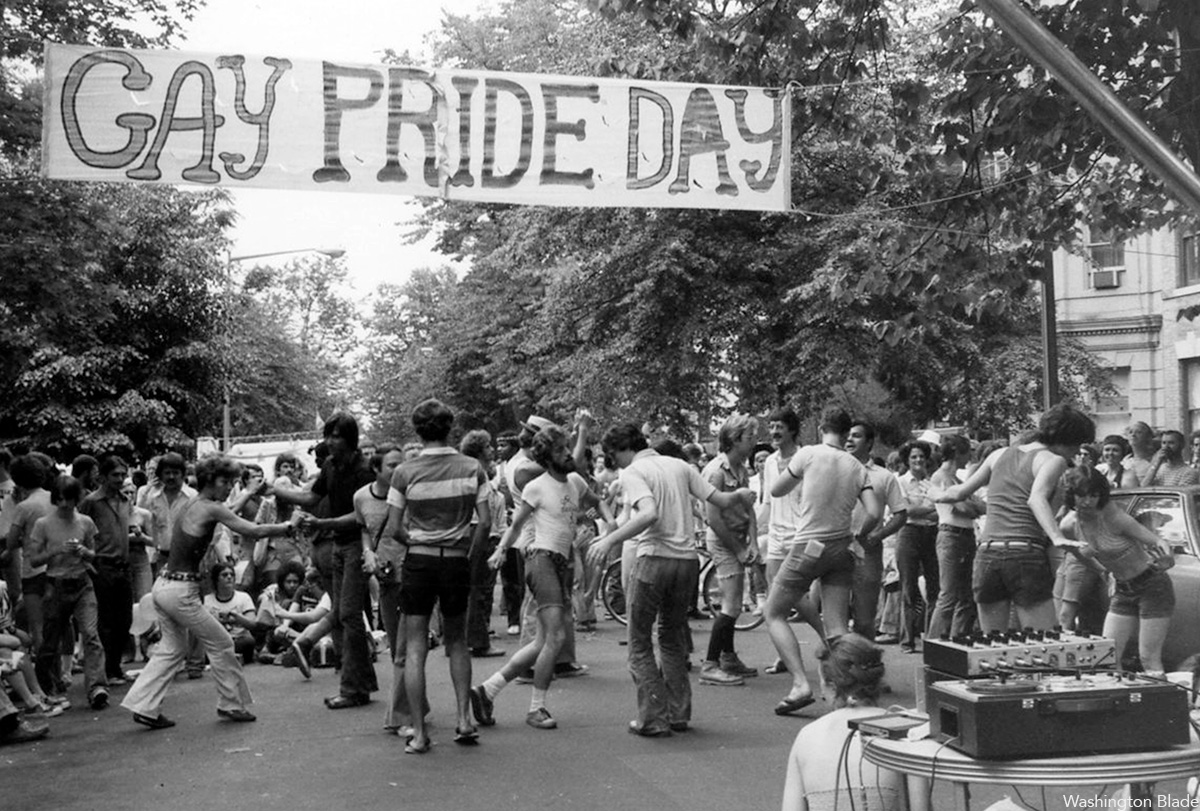
To celebrate the 50th anniversary of LGBTQ Pride in Washington, D.C., the Washington Blade team combed our archives and put together a glossy magazine showcasing five decades of celebrations in the city. Below is a sampling of images from the magazine but be sure to find a print copy starting this week.
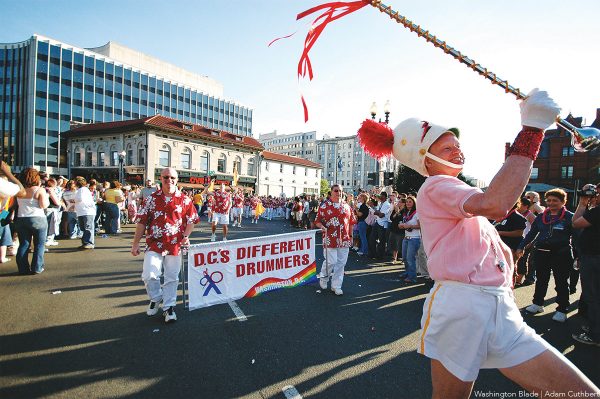
The magazine is being distributed now and is complimentary. You can find copies at LGBTQ bars and restaurants across the city. Or visit the Blade booth at the Pride festival on June 7 and 8 where we will distribute copies.
Thank you to our advertisers and sponsors, whose support has enabled us to distribute the magazine free of charge. And thanks to our dedicated team at the Blade, especially Photo Editor Michael Key, who spent many hours searching the archives for the best images, many of which are unique to the Blade and cannot be found elsewhere. And thanks to our dynamic production team of Meaghan Juba, who designed the magazine, and Phil Rockstroh who managed the process. Stephen Rutgers and Brian Pitts handled sales and marketing and staff writers Lou Chibbaro Jr., Christopher Kane, Michael K. Lavers, Joe Reberkenny along with freelancer and former Blade staffer Joey DiGuglielmo wrote the essays.
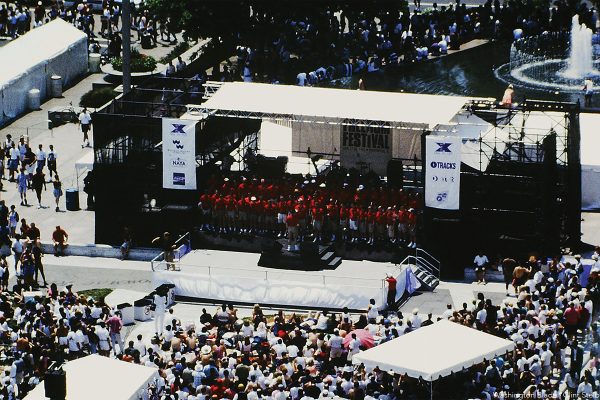
The magazine represents more than 50 years of hard work by countless reporters, editors, advertising sales reps, photographers, and other media professionals who have brought you the Washington Blade since 1969.
We hope you enjoy the magazine and keep it as a reminder of all the many ups and downs our local LGBTQ community has experienced over the past 50 years.
I hope you will consider supporting our vital mission by becoming a Blade member today. At a time when reliable, accurate LGBTQ news is more essential than ever, your contribution helps make it possible. With a monthly gift starting at just $7, you’ll ensure that the Blade remains a trusted, free resource for the community — now and for years to come. Click here to help fund LGBTQ journalism.
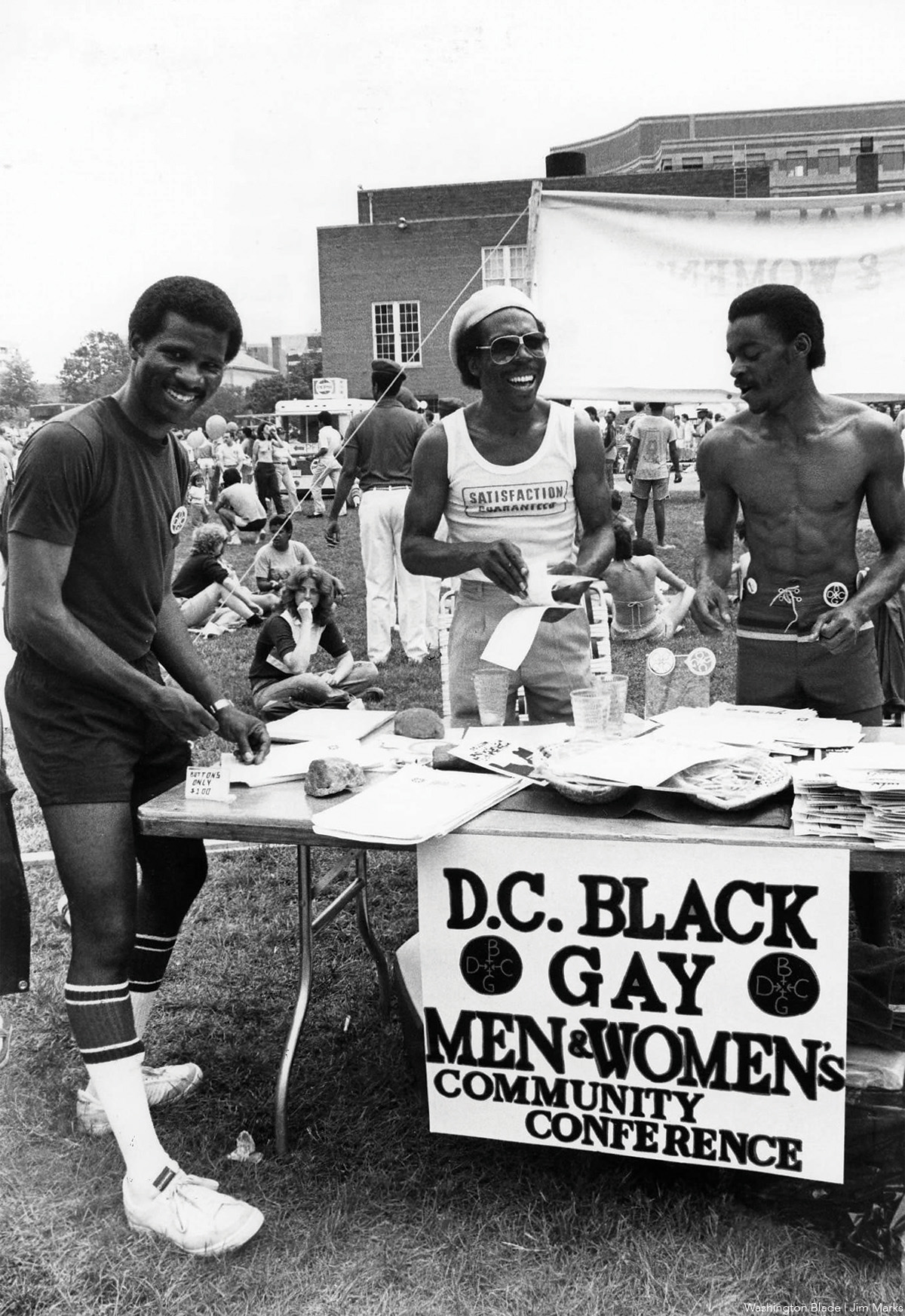
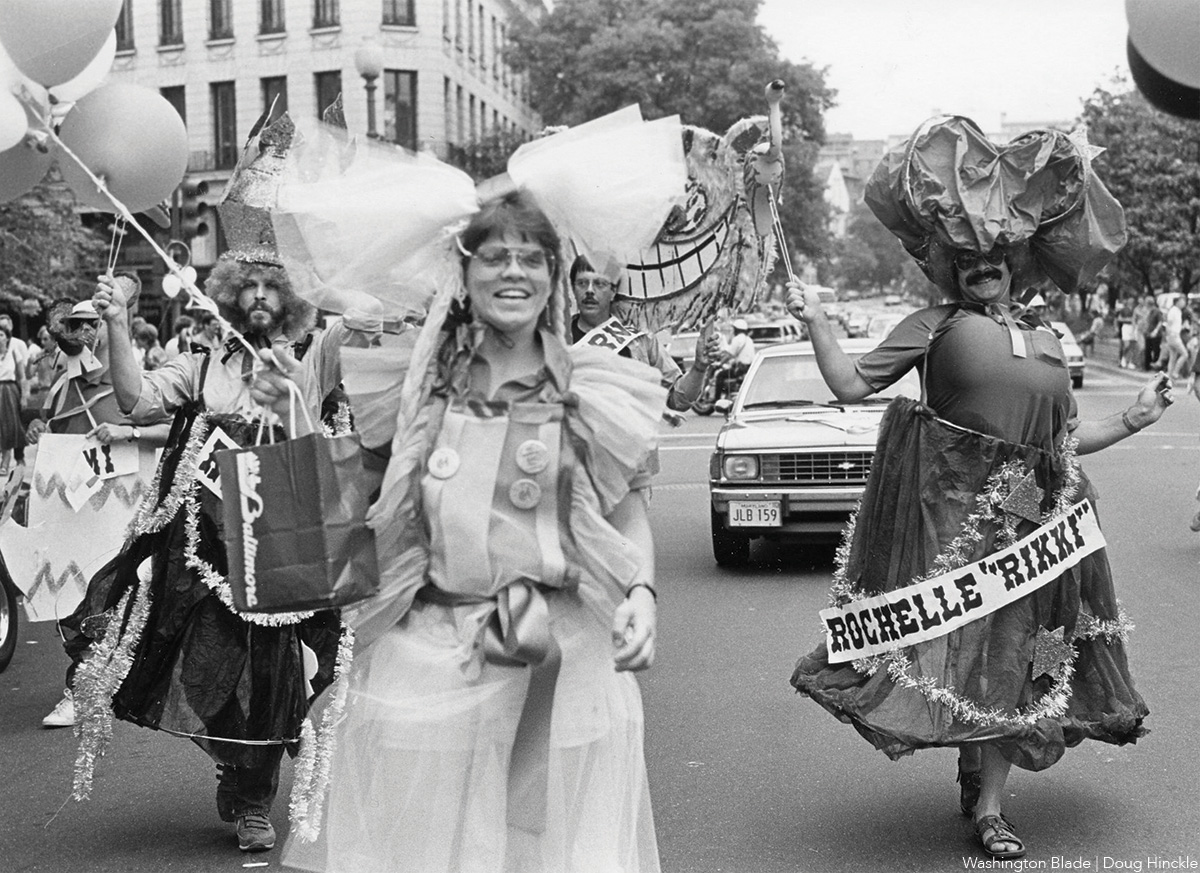
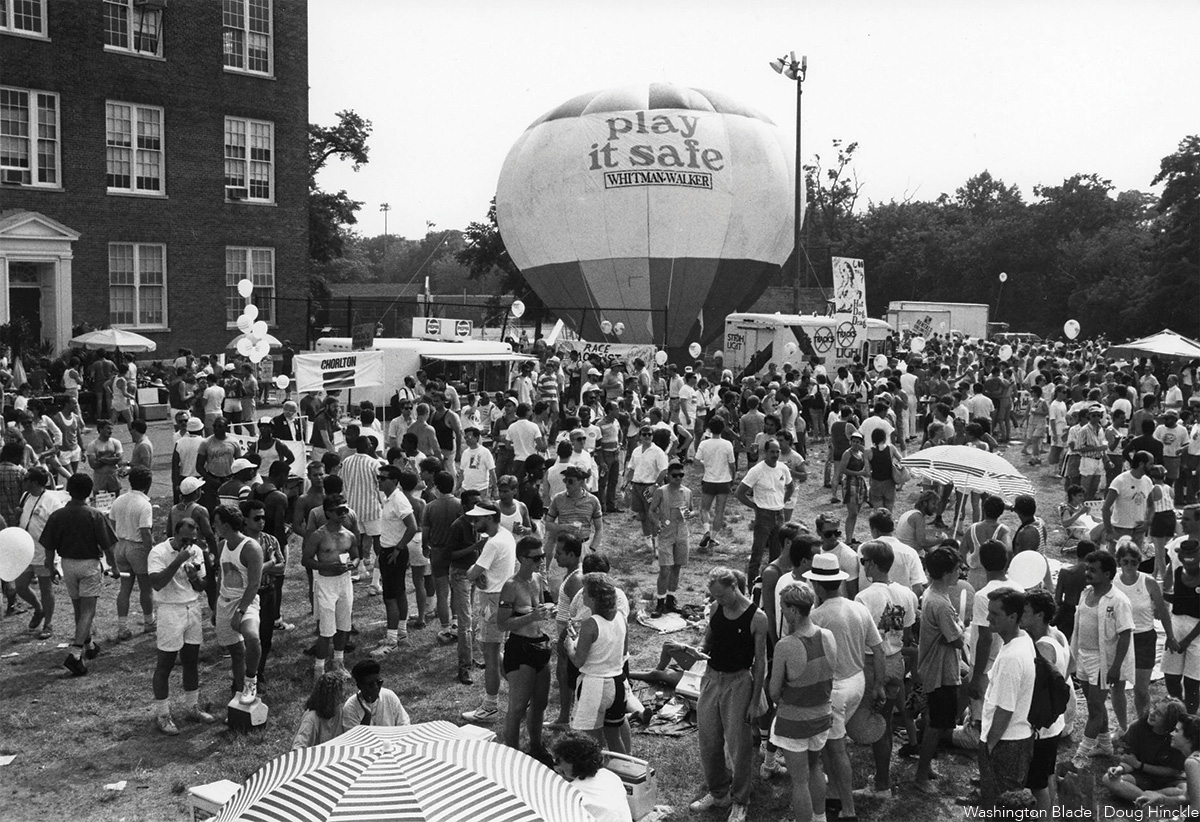
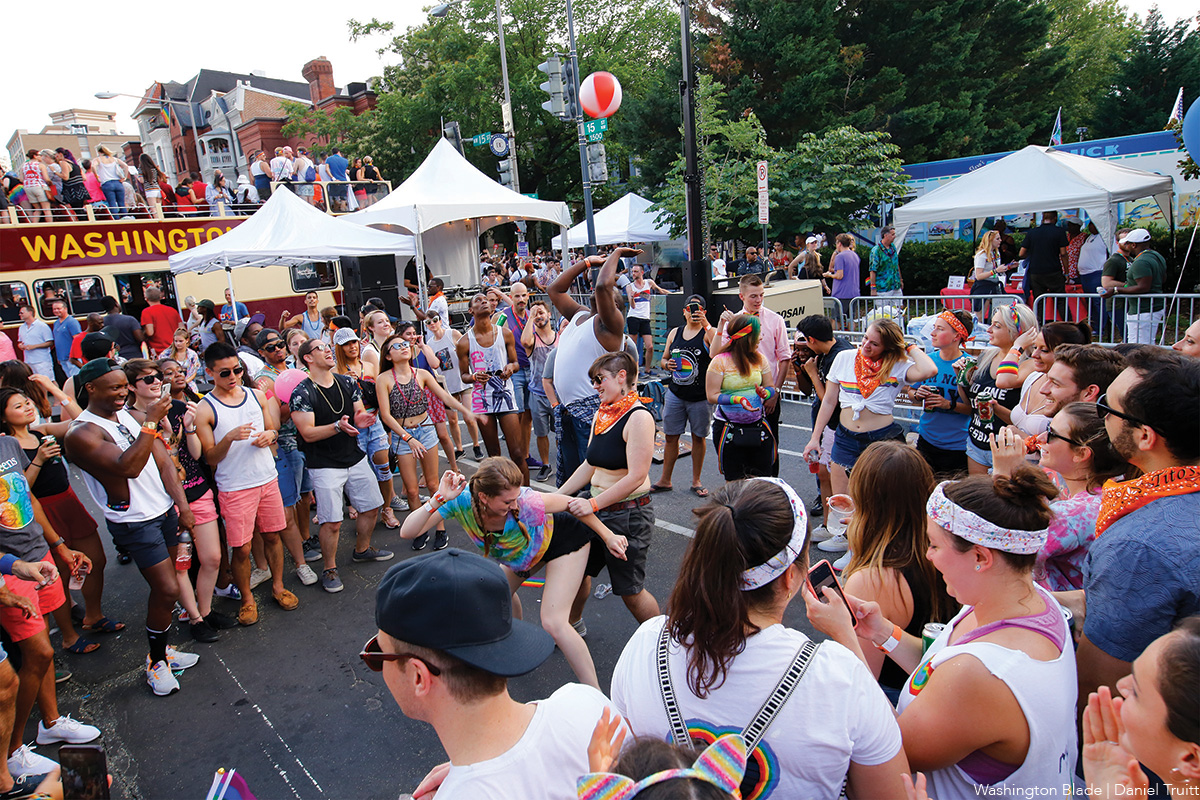
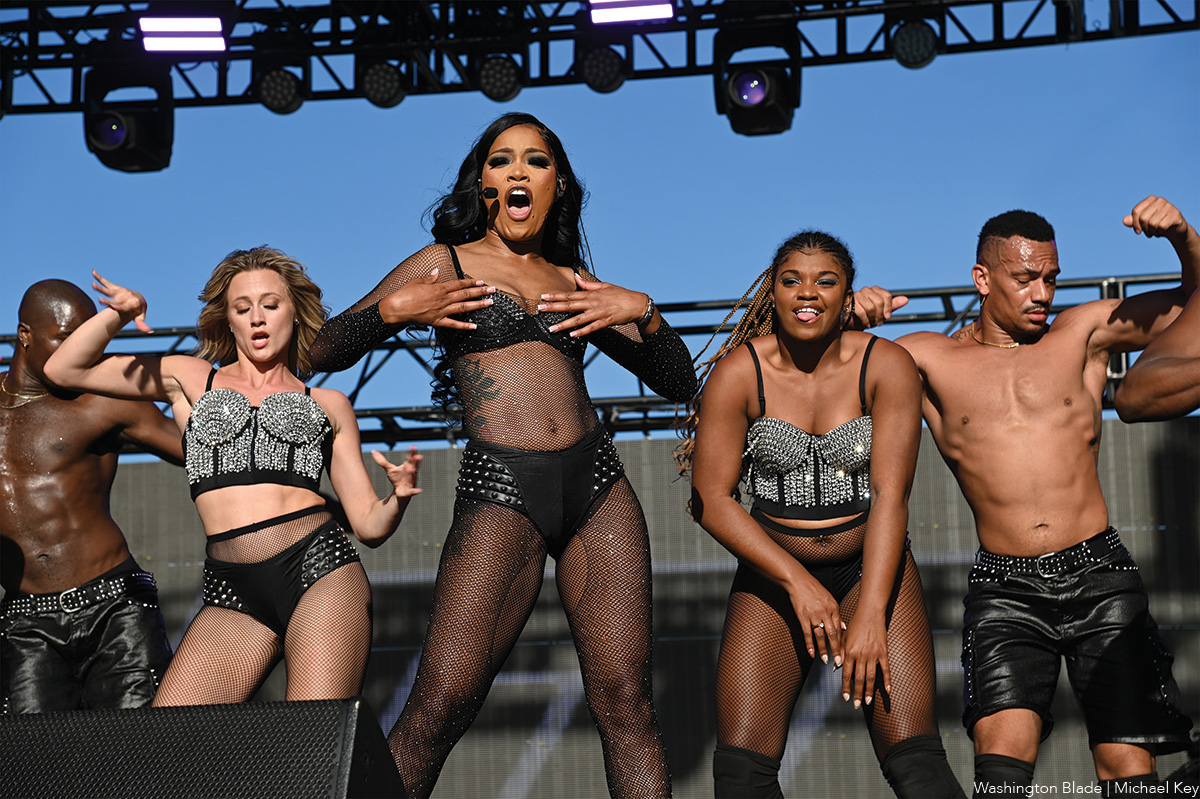
-

 U.S. Supreme Court4 days ago
U.S. Supreme Court4 days agoSupreme Court upholds ACA rule that makes PrEP, other preventative care free
-

 U.S. Supreme Court4 days ago
U.S. Supreme Court4 days agoSupreme Court rules parents must have option to opt children out of LGBTQ-specific lessons
-
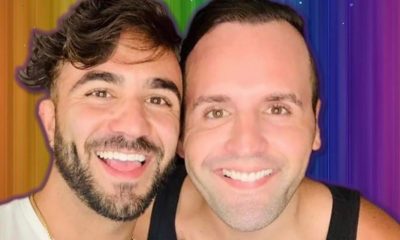
 District of Columbia5 days ago
District of Columbia5 days agoMan sentenced to 15 years in prison for drug deal that killed two DC gay men
-
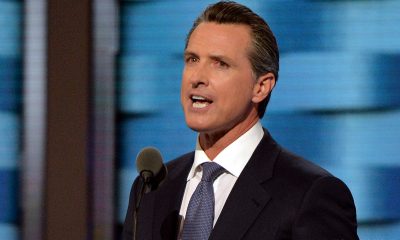
 Federal Government5 days ago
Federal Government5 days agoWhite House finds Calif. violated Title IX by allowing trans athletes in school sports





